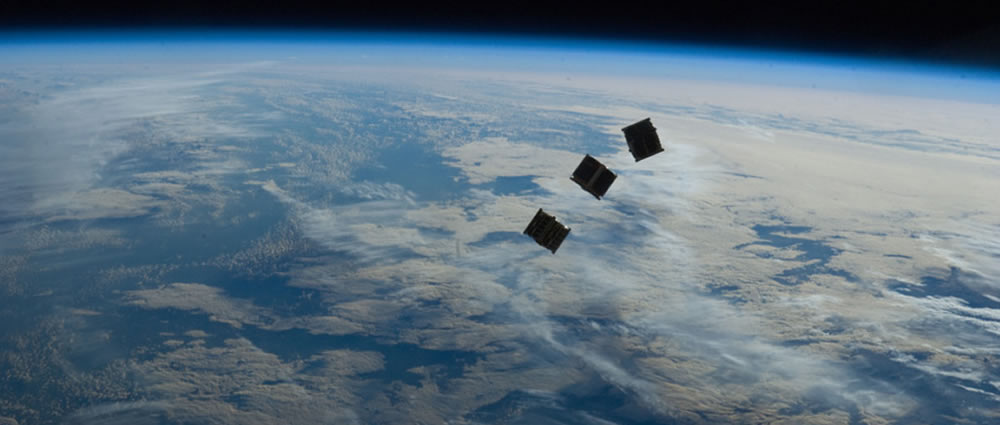-
Hashtag= #cubesats
Background:
CubeSats are tiny satellites, usually no more than about 4 inches on each side that can conduct space research using readily available, off the shelf hardware plus one of a variety of propulsion devices. So far CubeSats reach low-earth-orbit (LEO) only.
Interest in CubeSats is increasing in academia, in the commercial sector, and in NASA itself because of the relative ease of construction and relatively low cost to launch. Because of their size, multiple CubeSats can be launched as secondary payloads along with a large, primary spacecraft. This makes them ideal platforms for high-risk, experimental payloads and technology demonstration missions. They also allow small developers a means to access space, typically the domain of large companies and governments.
So far, all CubeSats have been delivered to low-Earth orbit. But the potential for a CubeSat to reach other celestial bodies is great: imagine if a small student group could send an experiment to Saturn. A commercial organization could use one to explore an asteroid for minerals. Or an amateur space exploration club could take the first images of a newly-discovered comet.
Recent research focused on the potential for interplanetary CubeSat missions has identified several primary areas that need further attention, including:
- Radiation-capable electronics
- Communications at interplanetary distances
- Propulsion technologies
- Low-thrust trajectories
- Miniaturized scientific instrumentation
- Onboard automoation
Challenge Description:
Develop a website that publicizes potential interplanetary destinations for CubeSat missions, and available launch opportunities. The website should challenge the public to find realistic trajectories to these destinations and should foster collaborative discussion about interplanetary CubeSat mission design. Together, these contributions will help build an “interplanetary atlas” for such missions and will help discover what is possible for CubeSat exploration.
Additional Challenge: Consider ways you could use a CubeSat to provide more information about an asteroid, such as developing a cubesat based sensor package that can be used to impact an asteroid and send back information about the minerals inside.
Functional Specifications:
Two target destinations are of interest, although you may think of others: near-earth asteroid missions and possible interplanetary missions. You can mine the publicly-available databases of asteroids and interplanetary destinations.
Imagine a 2015 launch using current propulsion technology, standard CubeSat size and reasonable satellite power requirements
Use trajectory-design tools such as NASA’s General Mission Analysis Tool (GMAT) to confirm feasibility.
Datasets
-
The Cubesat Project
http://www.cubesat.org/from CalPoly with info on CubeSat design, development, launch etc.
-
General Mission Analysis Tool
http://gmat.gsfc.nasa.govGeneral Mission Analysis Tool for trajectory simulation and design
-
Feasibility Study
http://www.nasa.gov/pdf/716078main_Staehle_2011_PhI_CubeSat.pdfStudy on feasibility of interplanetary CubeSats
-
Near Earth Object Program
http://neo.jpl.nasa.gov/nhats/database of accessible asteroids
-
Busek
http://www.busek.com/cubesatprop__main.htmCubeSat propulsion developer
-
Cubesat Designs/kits
Create Project Solving this Challenge
Need help?
Check out the comments to chat with other users working on this challenge or email the challenge creator with any questions.
-
The following projects are solving this challenge:
-
RoidCube
Our project is to design a website that contains all the necessary information about designing a mission using a Cubesat to reach asteroids passing near to Earth. The website contains information on available thrusters, launch service providers and published research papers that are available for... Visit Project
-
Asteroid mapper
Using a quadcoptor as a platform. This project will attempt to create a cubsat analogue that will autonomously mapping the surface of an asteroid. The goal is to modify an off the shelf quadcoptor with custom avionics that will permit autonomous flight, as a sonar that will perform the mapping. T... Visit Project
-
CubeWorld
The Space, the greatest mystery of mankind. but in 1999, something was up to change. That year the CubeSat was born. CubeSats are small satellites that typically cost under 50,000 dollars. Many enthusiasts were able to send a mission, but there was not a place to propose your own projects, un... Visit Project
-

CubeSats for Asteroid Exploration
Loading...
×
Loading...
×